Cars used to be like motorcycles still are (for now). You could even buy them with air-cooled engines, just like you can still buy bikes with air-cooled engines. No radiator to leak or water pump to fail or hoses to burst and leave you stuck by the side of the road – and later, holding an expensive repair bill.
Air-cooled engines are also light. They are usually made of aluminum – to dissipate heat more effectively – and they don’t need water jackets – or gallons of water sloshing around inside them. They make great economy car and sports car engines.
Air cooled engines (in cars) were killed off – not by lack of buyer demand – but by government demands. For the two usual reasons . . . saaaaaaaaaaaaaaaaaaaaaaaaaaaaaaaafety and emissions. If it wasn’t the car the air-cooled engine was in, it was the air-cooled engine itself. They run hotter. And it is harder to regulate their operating temperature within the narrow range necessary achieve compliance with Uncle’s latest exhaust emissions fatwas.
This last was what finally extincted the last air-cooled engine – the Porsche air-cooled boxer six – back in 1998. Not because it was “dirty.” There hasn’t been a “dirty” car made since the late 1980s.
It merely didn’t comply with the latest round of ever-stricter EPA standards, which by now split hairs over “Bins” and “Tiers,” with one Bin or Tier allowing fractionally less of this or that exhaust byproduct.
So, let’s have a look at what we can’t have anymore – and why.
Designed by Ferdinand Porsche (with input from you-know-who) back in the mid-1930s, the original Beetle was decades ahead of its time, which is probably why it remained in production largely unchanged for decades. It featured “one piece” unibody construction, with the body and structural frame welded together rather than having a separate (and heavy) stamped steel frame onto which the body panels were bolted, as was general practice at the time.
But the centerpiece of the car – what made it a work of genius – was its simple, compact air-cooled boxer four cylinder engine. The engine only weighed about 200 pounds (a modern water-cooled engine typically weighs twice that) and could be removed and installed by hand, by one man, with basic hand tools.
It had one belt – to drive a fan that not only forced cooling air over the engine but also directed warm air (heated by the engine) through clever ductwork into the car’s interior, to keep the passengers warm. And it warmed them almost immediately, even on ice-cold days – because air-cooled engines warm up much faster than water-cooled engines.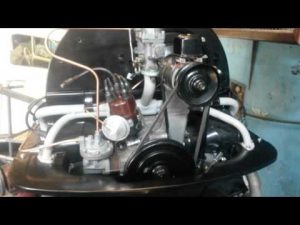
It’s true the ductwork sometimes also brought things besides warm air into the passenger compartment, but that was usually due to lack of maintenance (such as an oil drip from a leaking gasket) and easily and inexpensively fixable.
Which was the car’s other charm.
Four spark plugs, a set of contact points, some carburetor cleaner and a few basic tools were all one needed to tune up a Beetle. And because the basic car and most of its parts – mechanical as well as cosmetic – had been in continuous production for decades, largely unchanged, parts were easy to find and cheap. Parts that fit a ’75 usually fit a ’65. Or even a ’55.
It was one of the least-expensive cars to keep as well as to buy.
But it wasn’t . . . saaaaaaaaaaaaaaaaaaaaaaaaaaaaaaaaaaaaaaaaaaafe – as defined by government crash test standards. It didn’t matter that the Beetle was just as safe as an S-Class Mercedes sedan if you didn’t wreck it – and most people didn’t wreck theirs. All that mattered – from a legal/regulatory standpoint – was that the Beetle did not do as well as the S Class when it was purposely pile-driven into a barrier during government crash testing.
A car designed in the 1930s couldn’t meet saaaaaaaaaaaaafety standards decreed forty years later.
The last new one was sold here in 1977.
But you could still buy a new (old) Beetle in Mexico and other countries not subject to Uncle’s edicts for the next 20—plus years afterward.
* Chevy Corvair –
The real Super Beetle. Same concept: unibody, rear-engined and air-cooled engined. But on a grander scale.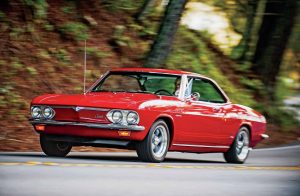
GM saw the success of the Beetle – and was envious. It was the late 1950s and more and more Americans were turning away from the increasingly dreadnoughtian land yachts that American car companies then specialized in. Particularly the emerging postwar youth market, which wanted something different.
Something more like . . . the Beetle.
Just, better.
The Corvair – which made its debut in 1959 as a new 1960 model – was the answer.
It was a small car, but much roomier inside – especially the back seats – which were human adult viable while the Beetle’s were cruel and unusual punishment. Also, the Corvair was available in multiple bodystyles – sedans as well as coupes – while the Beetle was always and only a two-door.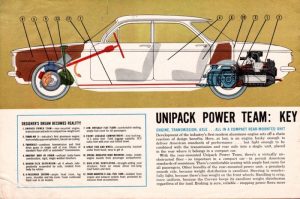
It had a huge trunk, too – so it was able to carry stuff as well as people.
And under the louvered rear cover, there was an air-cooled boxer six instead of a four. Just like a Porsche! You could even get it with four carburetors – or a turbo. But unlike a Porsche, the Corvair was affordable. Which accounted for the Corvair quickly finding fans GM never intended, who saw it as the poor man’s Porsche.
This proved fatal – with an egging on by a then-unknown shyster lawyer named . . . Ralph Nader.
The Corvair was a sensitive car. Tire pressures, which differed significantly front-to-rear, were critical because of the tail-heavy/nose light configuration – just like a Porsche. Porsche people – being sporting types familiar with these facts and used to the rear-engined car’s tendency to oversteer – drove their cars with the necessary respect and all was well. But some people who bought Corvairs didn’t maintain the tire pressure differential according to factory specs – filing all four to the same pressure – which induced dangerous oversteer when cornering at a fast clip, for which many of these people – sans the necessary wheelman skills – were not prepared. Nader exploited the negligence and incompetence of these drivers to smear the Corvair as “unsafe at any speed,” which it wasn’t.
If it was, then so was the Porsche 911 – and for that matter, the Beetle. All three shared a very similar layout/design, including their four-wheel independent suspensions and tendency to oversteer if pushed hard in a curve, particularly if the driver did the neophyte thing and took his foot off the accelerator mid-corner. This tendency was always made catastrophically worse by incorrect air pressure.
But that wasn’t the car’s fault.
Nader made hay – and became famous – false-witnesseing against the Corvair, which GM cancelled after the 1969 model year.
Instead of a light, efficient, simple car American buyers were purveyed genuine automotive atrocities such as the Vega – with its-prone-to-melt water-cooled/front-mounted engine.
Send a thank you note to Ralph.
The ugsome toad is still croaking around.
In the original Mad Max movie, Max is taken into the basement garage of the cop shop and shown “the last of the V8 interceptors.” The movie resonated with fans because at the time – it came out in 1979 – Middle Eastern contretemps had instilled great fear that gas would soon be either rationed or so expensive almost no one would be able to afford it anyway. As it turned out, V8 interceptors continued to be available – there are several such available today (e.g., the Dodge Challenger R/T, Chevy Camaro, Ford Mustang).
But you can’t buy an air-cooled Porsche any longer.
Not because of saaaaaaaaaaaaaaaaaaaaaaaaaaaafety. But because of fractionally/occasionally higher-than-allowable emissions.
The farce – the tragedy – is all the more so because of the minuscule number of air-cooled Porsches that were built. Unlike the Beetle and the Corvair, both of which were mass-produced in the hundreds of thousands (millions, in the case of the Beetle) the total production of air-cooled 911s (later versions were called 993s) from the first 1963 model through the last 1998 model is so low as to make the cars irrelevant as far as their emissions.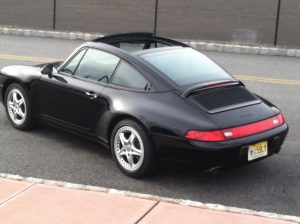
It is almost certain that a dozen or so army tanks foul the air more meaningfully than every single air-cooled 911, collectively, ever did.
But of course, Uncle’s toys are not subject to the same standards he imposes on our toys.
The air-cooled 911/993s weren’t the quickest Porsches. They are far outclassed by the new water-cooled Porsches as far as 0-60 and quarter mile times. But they were the last elemental Porsches. Like a Beetle, you can tell one’s coming by ear. The new water cooled ones’ sounds are muffled by all that water – and by all that metal (needed for the water jackets).
It is not the same.
They new ones are also heavier – and bigger. Tanks, in comparison with what went before.
That is, before Uncle – and his homogenizing, soul-sucking micromanagement of everything on wheels.
If you like what you’ve found here, please consider supporting EPautos. (Latest radio guest appearance can be heard here.)
We depend on you to keep the wheels turning!
Our donate button is here.
If you prefer not to use PayPal, our mailing address is:
EPautos
721 Hummingbird Lane SE
Copper Hill, VA 24079
PS: EPautos stickers are free to those who send in $20 or more to support the site. 


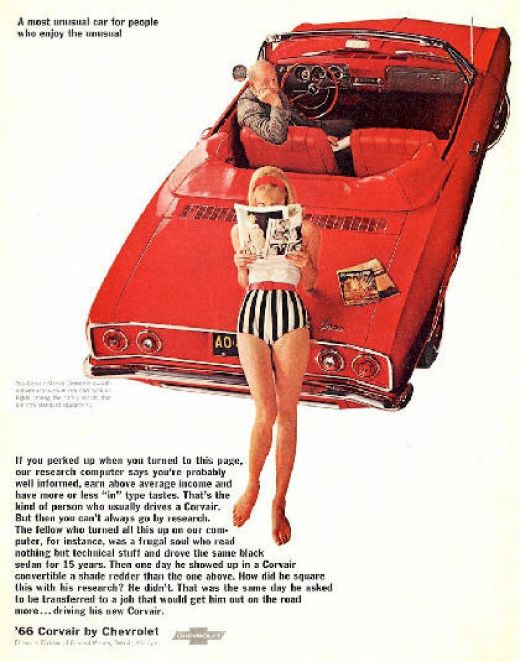

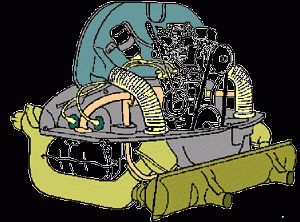
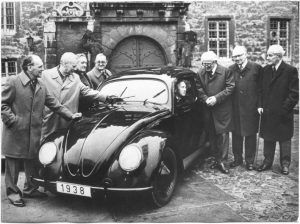








Eric,
This explains a lot. The only thing I have left to wonder is why Tucker’s people opted to modify his car’s air-cooled helicopter engine to become water-cooled.
Air cooled engines require “looser” tolerances. Water cooled engines can have “tighter” tolerances due to more precise temperature control.
Hi BaDnOn,
I don’t know for sure, but here’s what I suspect: The Tucker’s helicopter engine was designed to be cooled by the airflow a helicopter can provide. In a car, it may not have been possible to get enough air moving over it to keep it from overheating, in traffic especially. Helicopters don’t spend a lot of time idling on the tarmac!
Gotcha. Thanks Eric, and Anarchyst. The absence of air-cooled vehicles on the market has long perplexed me. My girlfriend and her family have had an especially difficult time with cooling systems, for one reason or another. ;p
Morning, BaDnOn,
It sucks about the air-cooling; even Porsche finally had to give in to Uncle and change the 911 to water-cooling because of “emissions.” I’ve owned several air-cooled vehicles, including a ’64 Corvair Monza I restored back in the early 2000s and the various old VWs I owned prior to that. Granted, you had to maintain the tinwork/cables/thermostats; but it was really nice to never have to worry about a heater core dumping coolant into the passenger cabin!
Accidentally met Ralph Nader once when he was running for president in 2008. He made an appearance at the local Cracker Barrel restaurant. Yes, for real! There he was in his cheap suit sitting in one of the rocking chairs they sell on the porch. He is off his rocker for sure…….
Evidently his campaign neglected to tell the restaurant they were coming (or if they wanted him to come to begin with). Management was not happen about it, having kicked him out of the dining room before I had come. That’s why he was on the porch cooling his heels. ha ha
Dad bought the first Corvair in town. Liked it so much he bought another one a few years later. Never ever considered a GM vehicle again after they caved to Nader and still complains bitterly about him.
He’s not a car guy, just really though the Corvair was an good vehicle. I guess years from now I’ll still be bitter over the end of the TDI.
An ordinary car above all needs boring and predictable handling. Abrupt changes between over and understeering for instance, is not something that ordinary people are supposed to handle when they drive. The Corvair unfortunately needed major modifications to the suspension, in order to get an acceptable and safe handling.
Probably the poorly engineered wheel suspension (cheating) was caused by a wish to save a little on the cost of the car. However, when you try to cheat on the proper engineering of a car and its suspension, then you usually only make problems for yourself.
My motto thus is as follows: “If you have to do it, then do it properly from the beginning. Fixing afterwards only leads to additional costs and problems”. If the Corvair’s suspension had been properly engineering from the start, then the car could have become a success, instead if a flop.
https://en.wikipedia.org/wiki/Chevrolet_Corvair#Handling_issues
Jone,
The Corvair’s suspension was very similar to the Beetle’s and the Porsche’s – as I tried to explain in the piece. (Can anyone read anymore?) Yet neither the Beetle nor the 911 was smeared as “unsafe.” Either they were – or the Corvair wasn’t.
I actually owned a Corvair, by the way. So I am well-acquainted with the car and assure you that it handled better than the majority of American cars of its time.
Want “unsafe at any speed”?
How about a 4,000 pound muscle car riding on 14 inch steel wheels… with a torsion bar/leaf spring/solid axle suspension and four wheel drum brakes…
eric, I had to stop and think of an American car that DID handle as well as the Corvair. A person could get in real trouble in a Corvette back then and I knew several who did. They only had the advantage of more weight in the front which wasn’t much advantage when one reached the limits of traction and the car couldn’t make up its mind, oversteer or understeer, oh, why not a bit of both?
On another note, the piece you wrote of violence toward the establishment was exceptionally well-done. I knew the Clovers(your political enemies)were waiting to pounce and say you were advocating violence when you rightly pointed out living by the gun can involve dying by the gun.
The Ft. Worth Star Telegram had done a smear job on the shooter as expected and glorified the Rep. from Tx. who hurt himself getting into the dugout where he kept his head down and didn’t yell encouragement to others getting their clocks cleaned.
In what was a typical set-up question and well-thought out response, the congressman was asked if he would seek re-election. After a predetermined pause he said Yes, then another dramatic pause and “yes…… I will”. A hero ex-baseball player turned pol milking it for everything it was worth. I narrowly missed puking on my keyboard. I would have said this yesterday but WP had other ideas and never let me have a comment box no matter how many times I loaded it. It’s a new world for WP every frickin day.
I keep thinking of muscle cars. Mine was 3400 lbs., coil springs and locating bars and stopped like a train. At full speed, about 150 mph, at which speed the front tires barely contacted the road, you could stand on the brakes and get it down to 120 at which point the brakes were history for a few minutes till they cooled. Honestly, the brakes were gone long before you got stopped from 90 or so at which point you stood on them and prayed.
Right on Eric- even further, my Volvo 850 & Buick Roadmaster wagon w/Lt.1 both rely on….wait for it….tire pressure differential front to back for optimum handling.
In fact, the 850 manual and gas door latch give you differing PSI ratings for 3 versus 5 people.
The hysteria Nader generated over the Corvair was just that- not only that, but I’ll bet with the proper research you’d have found just as many people per capita in the US wrapped their 911’s in the same era around telephone poles for the same reasons.
I love the 65′ up styling of the Corvair, the suspension “improvement” is obviously a bonus, but all it really did was make the car slightly more idiot proof. One might eventually land in my garage for a while. They are the last of the affordable classics that appeal to me.
Let us also not forget the NHTSA actually exonerated the Corvair years later(in 72′), though you never hear about that.
I have never driven an American car or a Corvair, so I admit that it is impossible for me to be fully objective. Wikipedia, however, mentions many lawsuits because of (unexpected?) crashes. There has to be some substance in this I suppose.
Beside from that, I can mention that the Beetle had a very weak engine, not inviting active driving. The Corvair on the other hand had powerful engines, probably inviting more active driving and possibly pushing closer to the limits. With regard to Porsche I suppose that they did not “forget” to include torsion bars on the 911 model, thus giving it an acceptable handling from the beginning.
My morale here is that cutting corners or including easy fixes often backfire on those who believe that this will be a success. I obviously do not question that you and some people can handle a car if it should abruptly shifts from neutral to very strong oversteering, but this is not for everybody.
Hi Jone,
The Corvair’s engine was only moderately powerful: 90-110 hp for most models; the turbo (rare) had 150. Keep in mind it was a larger/heavier car than the Beetle. Also, those hp numbers are SAE “gross” – so higher by about 20 percent than modern SAE “net” numbers.
An idiot can get into trouble in the weakest/slowest car.
As I mentioned in the article, the main problem with the Corvair was not the car but the owner. People who neglected to maintain the correct tire pressure – and who did not know how to drive, yet drove over their own limits.
Wikipedia simply vomited up the canards and half truths purveyed by the shyster lawyer, Nader.
Who, as others have pointed out, didn’t even drive – much less know anything about how a car works.
Hi Jone,
“Wikipedia, however, mentions many lawsuits because of (unexpected?) crashes. There has to be some substance in this I suppose.”
Meritless lawsuits are commonplace in the US. Combine a vain, publicity seeking, ignorant, self-anointed “consumer advocate” with an often gullible, always sensationalist, ethically challenged press; add in a group of ego wounded “victims”, desperate to make a buck and blame others for their own incompetence and lawyers will descend en masse.
Surely you remember the Audi case, same thing happened. After a dishonest and sensational 60 minutes episode featuring teary eyed victims and a rigged Audi that seemed to suddenly lurch forward for no reason, the parasites and opportunists jumped into action, nearly destroying Audi in the process. Three years later, the NHTSA concluded that the “problem” was due to driver misapplication of the pedals.
Here is a link you may find interesting: http://www.thetruthaboutcars.com/2010/03/the-best-of-ttac-the-audi-5000-intended-unintended-acceleration-debacle/
Here are a few choice quotes:
Viewers didn’t get to see the canister of compressed air on the passenger-side floor with a hose running to a hole drilled in the transmission. An “expert” had rigged the Rube Goldberg device to shift the big Audi into drive and, like any automatic-equipped car, move forward (unless the brakes are depressed).
The report concluded that the Audi’s pedal placement was different enough from American cars’ normal set-up (closer to each other) to cause some drivers to mistakenly press the gas instead of the brake. 60 Minutes did not retract their piece; they called the NHTSA report “an opinion.”
So the German automaker took it on the chin. Audi sales collapsed, from 74k units in 1984 to 12k by 1991. The timing added insult to injury; sales fell exactly during the same years when Lexus arrived to battle for the hearts and wallets of America’s up-scale consumers. Lexus quickly became the latest suburban driveway prestige symbol.
As a final kick to the near-corpse, Audi’s suddenly wanna-be-Lexus drivers launched a class action suit charging lost resale value. No wonder the brand almost abandoned the U.S. in 1993. It’s a killer market.
Jeremy
The problem with Nader is his claims have countless primary and secondary sources backing them up.
A website called thetruthaboutcars is not a source you can cite on wikipedia.
In order to survive, man has to discover and produce everything he needs, he has to alter his background and adapt it to his needs.
Nature has not equipped him for adapting himself to his background in the manner of animals. From the most primitive cultures to the most advanced civilizations, man has had to manufacture things; his well-being depends on his success at production.
The lowest human tribe cannot survive without that alleged source of pollution: fire. The ecologists and consumerists are the new vultures swarming to extinguish that fire.
Consumerism
No anti-concept launched by the Globalists goes so far so crudely as the movement tagged consumerism. It implies loudly and clearly that the status of consumer is separate from and superior to the status of producer.
What could be more obviously false, than that the consumer is king.
Consumer culture is a social system dedicated to the service of a new aristocracy which is distinguished by the ability to consume and vested with a special claim on the caste of serfs marked by the ability to produce.
There is no such thing as consumers’ rights, just as there can be no rights belonging to some special group or race and to no others.
There are only the rights of man—rights possessed by every individual man and by all men as individuals.
The right to be protected from physical injury or fraud belongs to all men, not merely to consumers, and does not require any special protection other than that provided by criminal law.
If a businessman—or any other citizen—willfully and knowingly cheats or injures others (consumers or otherwise), it is a matter to be proved and punished in a criminal court.
But the precedent which the consumer protection movement has established is the legal hallmark of a dictatorship: preventive law.
Preventive law— is the concept that a man is guilty until he is proved innocent by the permissive rubber stamp of a commissar or a Gauleiter.
What protects us from any private citizen who may choose to turn criminal and injure or defraud us? That, precisely, is the proper duty of a government.
But our government now assumes a totalitarian power and its officials are not subject to any law. So then now who will protect us from our protectors? What will be our recourse against the dishonesty, vindictiveness, cupidity or stupidity of a bureaucrat?
If matters such as science are to be placed into the unanswerable power of a single bureau, what will guarantee the superior wisdom, justice and integrity of the bureaucrats?
Why, the vote of the people, a statist gleefully cackles. The people choose the ruler who then appoints the bureaucrats. Those same people whom he does not consider competent to choose electric toasters, credit contracts, face lotions, laxative tablets or canned vegetables.
Consumers are free, producers are enslaved. The Globalist social order is based on the following tenets:
1 you’re incompetent to run your own life, but competent to run the lives of others
2 you’re unfit to exist in freedom, but fit to become an omnipotent ruler
3 you’re unable to earn your living by the use of your own intelligence, but able to judge politicians and to vote them into jobs of total power over arts you have never seen, over sciences you have never studied, over achievements of which you have no knowledge, over the gigantic industries where you, by your own definition of your capacity, would be unable successfully to fill the job of assistant greaser.
What the fuck are you talking about?
Sorry John, that comment was written at a 12th grade level. It gets a C grade for using too many big words.
https://readable.io/text/
Did you attend a public school? Former private Catholic inmate myself.
If you need things dumbed down and rewritten at a 6th grade level, I can do that, or would that still be beyond your comprehension.
IYou see John, I used to be like you. With the same chip, but mine
became a boulder on my shoulder left me feeling kinda older as I road tripped life’s merry-go-round
Felt this very unpleasing sneezing and wheezing
as Eric chronicled the calliopes crashing to the ground
Eric is the true go-kart mozart daily checking out the political weather charts to see how unfree & unsafe it is outside
While at my work there’s some brimstone baritone anticyclone rolling stone preacher from our HQ in the east
Tells me dethrone the dictaphone hit it in it’s funnybone
‘Cause hat’s where they expect it least
Back home some new mown chaperone is standing in my kitchen corner iand watching my young girls dance
While some fresh-sewn moonstone is messin’ with my wife’s frozen zone reminding her of romance
Everday I’m blinded by false light revved up like a deuce
that I take driving in the night blinded by flashing trouble lights while once again
last night she got down but still never got tight we’re gonna make it through another night
Hey Tor,
I tested my latest comment to Nunzio and it received a C, with an average grade level of 12.3. They too admonished me for “too many long words”. They, thoughtfully, highlighted all of my excessively long words and suggested I try replacing them with something shorter. So, here’s the list:
hypothetical, organization, necessarily, voluntarily, liability, monopolistic, imperialism, temporarily and libertarian.
I’m struggling to find shorter alternatives, can you help?
I then tested this: I have a dog. He makes me happy. I was sad when he died.
That got an A.
I think I’m going to strive for a D.
Cheers,
Jeremy
I tested the Air-Cooled Oddballs article. It got a B grade for readability.
Readability Grade is 9th grade level. Tone is formal. Sentiment is neutral.
A 7 minute read. Word type counts:
Adjectives 141
Adverbs 113
Conjunctions 180
Nouns 428
Prepositions 149
Pronouns 68
Verbs 235
Word Count 1,511
Sentence Count 95
Wonder how these metrics compare to something written by Mencken?
Hi Tor,
I sent this e-mail to the folks at readability.
“Hello,
I am interested in your service and have tried the basic version of what you provide. However, I am reluctant to sign up until I receive a response to my query.
I recently measured the readability of a sample of my writing and received a grade of C for “using too many long words”. My average grade level score was 12.3. You deemed the following words to be too long and suggested that I use shorter alternatives: hypothetical, organization, necessarily, voluntarily, liability, monopolistic, imperialism, temporarily, libertarian and imaginary.
Please suggest shorter alternatives to these words that convey essentially the same meaning.”
They have not responded.
Jeremy
Hey Tor,
I missed one. They admonished Mencken for using imaginary.
BTW, I loved your rewrite but it only works if imagining (just short enough, phew) the original.
https://www.youtube.com/watch?v=j9Kl3HvJ7os
Jeremy
I suppose that statistics can provide the correct answers here. If the pedal arrangement in the Audi in 1991 was sufficiently different from what was common, then this boils down to whether their cars accelerated unintended noticeably more often that other typical cars with automatic transmission, or not. If they did, then Audi was to blame.
The same applies to Corvairs. If statistics show that they had more crashes that other cars because of sudden oversteering, then that car had a design flaw that needed fixing. Ordinary cars are not driven by racer drivers and ordinary people are not supposed to handle sudden unexpected changes from neutral handling to oversteering. Abrupt and unexpected changes in the car’s handling are much more dangerous, than not having the best possible general road holding.
In my opinion it is also not an acceptable solution to prescribe a very high tire pressure, more than recommended by the tire manufacturer, in the rear wheels. This “easy way out” was something that that the car’s designers should have avoided from day one.
Thank you for your relevant and friendly feedback. I appreciate that.
Hi Jone,
I have two lathes, a milling machine, a drill press, a belt sander and a bench grinder in my shop. All of these tools are dangerous. It is incumbent upon me to learn how to use them safely. Even my hand tools can be dangerous if I don’t use them properly.
There was nothing wrong with those Audis. They were European cars and had a pedal configuration that was common in Europe. It is the responsibility of the owner to learn how to drive their cars. Every time I rent a car, I take the time to familiarize myself with the controls before I drive it. Idiot proof engineering will never be sufficient to prevent accidents, but it does encourage idiocy.
Liability based engineering also produces stupid and inferior “innovations”. For example, the venerable quick release skewer, invented by Tulio Campagnolo, is being phased out of road bikes due to this idiocy. Within a few years, all road bikes will be equipped with thru-axle skewers, which are “slow-release” at best. We are told that it’s better, stiffer, etc… But, the real reason is that the better technology (at least for road bikes) of a quick release skewer is dying because of liability concerns.
As for the Corvair, GM did not proscribe a very high rear tire pressure that exceeded the tire manufacturers recommendations. They proscribed a lower pressure for the front tires.
Kind Regards,
Jeremy
Hi Jone,
I have personal experience with how easy it is to “misapply the pedals”. A few week ago, I needed to move my wife’s car from under the carport. I decided that I didn’t need to start the car, so I got in, put it in neutral and, with my left foot, got the car moving enough to roll out of the carport. Now, I’m sitting in a weird position with one leg hanging outside of the door so, when I went to apply the brake, I hit the clutch instead. Of course, the car didn’t stop. I moved my foot and tried again, same result. I was sure that I was pressing the brake pedal and I only had about 10 feet left before the car hit the wall that surrounds my property. My lizard brain took over and I pressed harder on the clutch. Luckily I managed to stop the car inches before it hit the wall by dragging my left foot, Flinstone’s like, in the gravel.
After it was over, I realized what I had done and was embarrassed by my reflexive and stupid action. What I didn’t do was insist that the brake had suddenly stopped working.
Cheers,
Jeremy
Europeans who were used to rear engine cars would have had no problem with the Corvair. Corvair’s “flaw” was that its suspension design was slightly behind that of some other rear engine rear drive cars. Which is to be expected as GM offered it as an affordable economy/family/entry level car.
So here’s this ‘different’ domestically made car that handles in way most people in north america don’t expect plus it’s not entirely ‘state of the art’. This is blood in the water to a lawyer like Nader. All he has to do is paint GM as callous and that’s that. ca-ching. Money in the bank. He started a new parasitic industry that gets copied again every few years.
That’s truer than you’re giving yourself credit for. More than mere industry, its a Governing Moral Philosophy.
Nader is the anchor baby of two Lebanese parents and the bizarro John Galt founder of the Parasite’s Gulch.
Both Jews and Gentiles have adopted the smug superiority of having a subscription to Consumer Reports. True patriots of the anti-industrial revolution.
In 1789 the Founding Father Producers manufactured this nation. And ever after we are to be Obedient Consumers who can comparison shop the World’s Nations as savvy purchasers.
But never can we again be producers who launch new endeavors. For the producers must serve the mass of empowered eaters who are free to vote on how dependents may compel the providers to give us the goods.
Providers have only one vote, which is vastly outnumbered.
Their only hope is to invest their earned surplus in lobbyists and other Mao-type geniuses like Nader. Which leads us to Koch bros and Gary Johnson and other half-measures better than the status-quo but still so the far from Laissez Fair Non Agression we seek.
Hi Brent,
Nader, and those like him, are far more dangerous and despicable than the average opportunistic shyster, who at least knows what he is doing.
C.S. Lewis nailed his type years ago.
“Of all tyrannies, a tyranny sincerely exercised for the good of its victims may be the most oppressive. It would be better to live under robber barons than under omnipotent moral busybodies. The robber baron’s cruelty may sometimes sleep, his cupidity may at some point be satiated; but those who torment us for our own good will torment us without end for they do so with the approval of their own conscience.”
Jeremy
Ah the simpler days of yore..
Before going with a ’78 924 as my 2nd car ever, I test drove an air cooled(+fan) Porsche 914 some motorheaded farmer had for sale in ’83.
’70 Porsche 914 Resto Project
https://www.youtube.com/watch?v=YSMDwgTJV2s
914 teck speck
https://en.wikipedia.org/wiki/Porsche_914#Technical_specifications_of_the_standard_versions
Actually the VW Beetle was not a unibody design. The floorpan served as the frame an the body was bolted to it. This made possible the proliferation of bolt-on fiberglass dune buggy and sports car type bodies that were popular in the Beetle’s day.
I always liked Corvairs, had one ages ago. At one time GM planned a next-generation modular Corvair type flat air-cooled engine that could be built with 2 to 12 cylinders to fit different vehicles:
http://www.curbsideclassic.com/automotive-histories/engine-prototype-the-stillborn-corvair-gen2-modular-engine-from-two-to-twelve-cylinders/
Ralph Nader doesn’t drive…never has…
I wish everyone had known Ralph wasn’t a driver. I recall Tom McCahill taking a Corvair after a lot of bs thrown by Nader and trying to make it flip. He even got on a heavily rutted logging road and still couldn’t get it to roll.
I knew a lot of people who owned Corvairs(and more who owned Bugs)who had no problems with them. At least you could get a Corvair with an a/c, no small thing in Tx.
I knew a girl who had the engine fall out of her Corvair but not to worry, her dad retrieved it and stuck it back in. Knew a guy with a Spider who thought of himself as a high speed race driver and if ever there was a case where a car should have flipped, it was his. He had the most spastic driving style I ever saw and influenced a friend of mine to drive as he did, turn the wheel real hard deep into a curve and do it again as necessary to stay on the road……insanity. I finally got it across to my buddy he was going to be pasture fodder doing that with his pickup and his dad’s big Galaxy.
Back in the day,I used to race Formula Vees in the SCCA Formula Vee Class. It was affordable and fun yet serious racing. The cars were easy to work on and relatively inexpensive to run. Unlike the other Formula Classes that relied on relatively expensive parts. If it wasn’t for Formula Vee I wouldn’t have been able to afford to race. Yet for 10 years I traveled up and down the East Coast from Lime Rock Conn.to Summit Point Raceway WV. and many stops in between. I lived the racer’s life on a shoestring budget,but what fun.
I love that Corvair ad………….”If this hot piece of ass give you a hard-on, so will our new car!” (and for less trouble and $$$$ most likely)
’65 Vair International Byooty TV Commercial
https://www.youtube.com/watch?v=59voKreB2j8